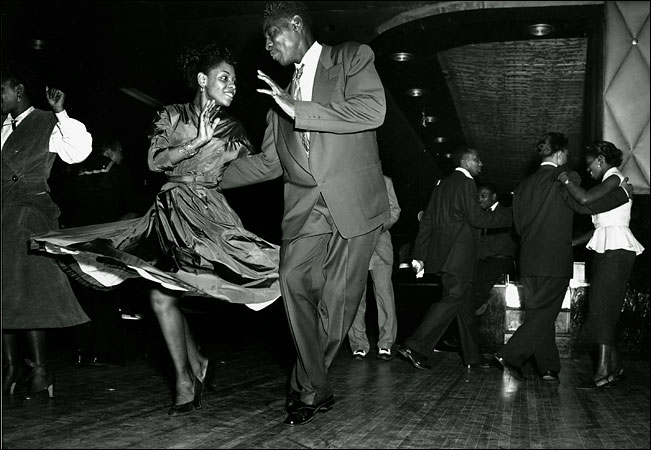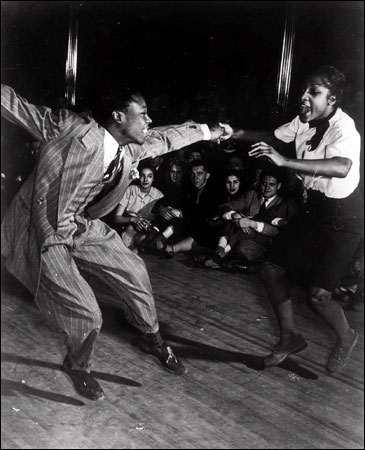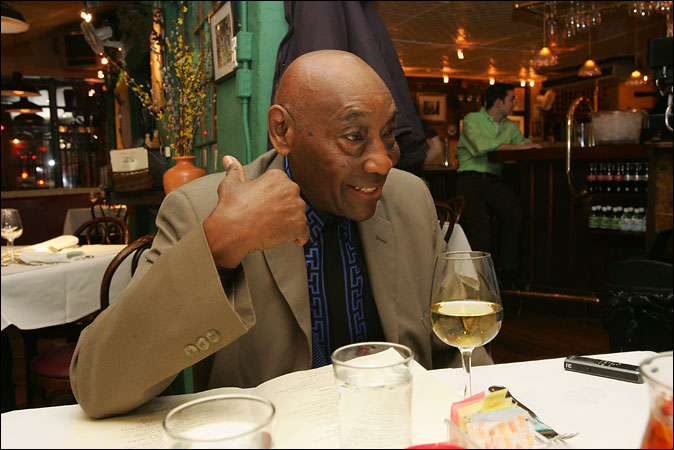| Want to send this page or a link to a friend? Click on mail at the top of this window. |
| Posted March 13, 2006 |
 |
Associated Press |
| Five decades after it closed in Harlem, the Savoy Ballroom is still revered. Today, ex-dancers will celebrate the 80th anniversary if its opening. |
| Where Feet Flew and Lindy Hopped |
| ___________________________________ |
| The Savoy Had a Thing, and That Thing Was Swing |
By MANNY FERNANDEZ |
The night Frankie Manning flipped Frieda Washington over his back in a heels-over-the-head maneuver on the dance floor of the Savoy Ballroom in Harlem, he was more than a little nervous.
The year was 1935, the song was "Down South Camp Meeting" and the occasion was a swing dance contest that featured six pelvis-shaking couples. Mr. Manning, then 21, and his partner, Ms. Washington, were the last to compete.
"I had to follow all them other teams that went out there and tore the floor," he said. "Shorty Snowden, who was the greatest dancer in the world as far as I was concerned, had just danced in front of me and I was saying, 'Man, I ain't going out there.' " But as Chick Webb and his band played, the couple locked arms, and Mr. Manning, his back to hers, bent over and catapulted Ms. Washington over him, a split-second feat they had rehearsed beforehand with his bedroom mattress close by, just in case.
That move — the first Lindy Hop air step, according to the International Encyclopedia of Dance — did more than earn his team a victory that night. It helped make him a dancing legend.
Over the years he would become a courtly ballroom ambassador, teaching the swing dance styles to eager couples from around the world.
 |
Cornell Capa |
| Rousell Williams and Connie Hill, above, at the Savoy Ballroom about 1939. |
But for Mr. Manning — now a 91-year-old grandfather, retired postal worker and recent inductee into the Hall of Fame at the National Museum of Dance in Saratoga Springs, N.Y. — it was just another night at the Savoy.
Dance halls come and go in New York City as quickly as fashion trends and pizza parlors. But nearly 50 years after its death, the Savoy has lived on, if only in revered memories.
On Lenox Avenue between 140th and 141st Streets, the ballroom was a blocklong rhythm factory that set New York's jazz-fueled tempo in the 1930's and 1940's.
 |
Michelle V. Agins/The New York Times |
| Frankie Manning flipped his partner over his head in 1935, earning his dance team a victory. Now 91, he is a Hall of Fame inductee in the National Museum of Dance. |
On any given night, thousands packed the hardwood dance floor as Duke Ellington, Ella Fitzgerald or Count Basie supplied the tunes, inspiring the kind of moves that prompted someone — former patrons like saying it was Lana Turner — to call the place "the home of happy feet."
This evening, the ballroom's birthday, Mr. Manning and more than 100 others who danced or played music at the Savoy are gathering to remember it, celebrate their youth and, naturally, dance.
The Savoy — it opened March 12, 1926, and closed July 10, 1958 — was torn down and a housing complex called the Delano Village took its place.
Some of the former musicians and dancers plan to meet at a plaque marking the spot at noon, attend panel discussions on the Savoy's influence on American dance history and then finish off the evening with a dinner and dance at the nearby Alhambra Ballroom.
The event was organized by three men who never saw the Savoy Ballroom for themselves: Elliott Donnelley, who runs a production company based in San Francisco that sponsors Lindy Hop events; Chad Fasca, who directs the swing program at the Sandra Cameron Dance Center in Manhattan; and Terry Monaghan, a dance historian from London who operates a Web site about the Savoy, www.savoyballroom.com.
During a revival of swing dancing to big-band music in the late 1980's and 90's, the Savoy's history enjoyed a resurgence of interest. A younger generation of dance enthusiasts looked upon it as a cultural phenomenon that inspired high-flying invention on the dance floor and brought blacks and whites together in a time of segregation.
"The Savoy opened the doors for all people being together," said Norma Miller, 86, who along with Mr. Manning was an original member of Whitey's Lindy Hoppers, top Savoy dancers assembled by Herbert White, a former ballroom bouncer who was known as Whitey. "We were the first people in the world who were integrated. We didn't have segregation at the Savoy."
Mr. Manning said patrons were judged by their talent on the dance floor, not the color of their skin. Not even the celebrities received special treatment. One night, someone approached Mr. Manning and his friends. "Somebody came over and said, 'Hey man, Clark Gable just walked in the house.' Somebody else said, 'Oh, yeah, can he dance?' " Mr. Manning recalled. "All they wanted to know when you came into the Savoy was, do you dance?"
In the spring of 1944, the dance floor at the Savoy was where Martha Hickson first met the man she later married. Ms. Hickson is white; her husband, Foster Hickson, was black. They were married nearly 50 years, until her husband's death in 2000. "He had a particular way he would lift his feet," said Ms. Hickson, 80, who planned to attend the celebration today. "He called it the Apple Jack. I don't even have to close my eyes. I can see him doing that right this minute."
The Savoy's dance floor used to bounce with the force of all those happy feet, and few remember it better than Bill London. He was one of a group of neighborhood teenagers who helped clean the ballroom in the early morning hours, sweeping the dance floor and picking up trash.
When he was older, on leave from the Army, he returned to dance.
"I was going there to have fun and to get women," said Mr. London, 70. "I cannot lie. But you had to be able to dance."
Copyright 2006 The New York Times Company. Reprinted from The New York Times, New York Report, of Sunday, March 12, 2006.
| Wehaitians.com, the scholarly journal of democracy and human rights |
| More from wehaitians.com |